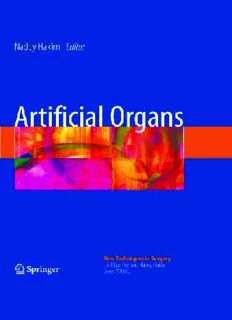
Artificial Organs PDF
Preview Artificial Organs
New Techniques in Surgery Series Nadey Hakim (Ed) Artificial Organs 1 3 Editor NadeyHakim RenalandTransplantServices HammersmithHospital London,UK ISBN978-1-84882-281-8 e-ISBN978-1-84882-283-2 DOI10.1007/978-1-84882-283-2 BritishLibraryCataloguinginPublicationData AcataloguerecordforthisbookisavailablefromtheBritishLibrary LibraryofCongressControlNumber:2009920379 #Springer-VerlagLondonLimited2009 Apartfromanyfairdealingforthepurposesofresearchorprivatestudy,orcriticismorreview,aspermitted under the Copyright, Designs and Patents Act 1988, this publication may only be reproduced, stored or transmitted,inanyformorbyanymeans,withthepriorpermissioninwritingofthepublishers,orinthecase ofreprographicreproductioninaccordancewiththetermsoflicensesissuedbytheCopyrightLicensingAgency. Enquiriesconcerningreproductionoutsidethosetermsshouldbesenttothepublishers. Theuseofregisterednames,trademarks,etc.,inthispublicationdoesnotimply,evenintheabsenceofaspecific statement,thatsuchnamesareexemptfromtherelevantlawsandregulationsandthereforefreeforgeneraluse. Productliability:Thepublishercangivenoguaranteeforinformationaboutdrugdosageandapplicationthereof containedinthisbook.Ineveryindividualcasetherespectiveusermustcheckitsaccuracybyconsultingother pharmaceuticalliterature. Printedonacid-freepaper SpringerScienceþBusinessMedia springer.com Foreword Artificialorganshavecomealongwaysincethefirstdialysismachine,therotating artificialkidney,wasinventedin1944byWillemJohanKolff,whoisknownasthe ‘‘father of artificial organs’’. At that time he met stiff resistance from his hospital superiorsbuthispersistencepaidoffandamillionsavedliveshavebeenattributed tohisfirstinvention.Hewasindeedthefirsttomixmedicineandengineering.An artificialorganisanymachine,device,orothermaterialthatisusedtoreplacethe functionsofafaultyormissingorganorotherpartsofthehumanbody.Somebody parts are more of a challenge than others. The heart has one purpose and it is to pumpblood;however,theliverhasbiochemicalandphysiologicalfunctionswhich aredifficulttosimulate.Theimplantationofanartificialorganiscriticalbecauseof thepatientlifedependencyontheartificialorgan itself.The treatment ofchoiceis organtransplantation,however,transplantcandidatesfacealongwaitingtimeand manydiewhileonthewaitinglist.Inadditiontherearepatientswhoareexcluded from transplantation because of age or presence of other diseases. This book pre- sentsanoverviewofthecurrentstateofknowledgeofartificialorgansincludingthe liver, pancreas, kidney, heart, cochlea, skin, stem cells, composite tissue allograft, andsphincters.Itisdesignedforstudentsinterestedinthefieldoforganreplacement and bioartificial organs and it promotes an understanding of the designs and materials required for successful implants. It fulfills a useful place in the medical literature.Theeditorshavegatheredtogetherexpertsinavarietyofdifferentfields both from the experimental and clinical aspects. Research in the field of artificial organswillleadtoacloserrelationshipbetweenscienceandtechnologyandprovides asteppingstoneforthefuture. ProfessortheLordDarziofDenhamKBE v Contents 1 ManagementofMultiorganFailureAfterArtificialOrganImplantation MichaelDevile,ParindPatelandCarlosMHGo´mez................. 1 2 ArtificialCirculatorySupport JohnMulholland.............................................. 21 3 TheArtificialKidney ChristopherKirwanandAndrewFrankel.......................... 39 4 LiverSubstitution SambitSenandRogerWilliams ................................. 57 5 GlucoseSensorsandInsulinPumps:ProspectsforanArtificialPancreas MartinPress................................................. 77 6 FromBasicWoundHealingtoModernSkinEngineering L.C.Andersson,H.C.NettelbladandG.Kratz....................... 93 7 ArtificialSphincters AustinObichereandIbnaufSuliman ............................. 107 8 CochlearImplant GeorgeFayadandBehradElmiyeh............................... 133 9 StemCellsandOrganReplacement NataˇsaLevicˇar,IoannisDimarakis,CatherineFlores, EvangeliaIProdromidi,MyrtleYGordonandNagyAHabib.......... 137 10 CompositeTissueTransplantation:AStageBetweenSurgical ReconstructionandCloning EarlR.OwenandNadeyS.Hakim ............................... 165 Index........................................................... 179 vii Contributors LCAnderssonMDDrmedPhD AndrewFrankelMBBSMDBScFR ConsultantPlasticSurgeon ConsultantNephrologist AnelcaClinic WestLondonRenalandTransplant SpecialistClinicforAesthetic Centre andReconstructivePlasticSurgery ImperialCollegeHealthcareNHSTrust London HammersmithHospital UK London UK MichaelDevileBScMBBSMRCP(UK) SpecialistTraineeRegistrar CarlosMHGo´mezLMSFRCAMD inAnaesthesia EDICM OxfordDeanery ConsultantinIntensiveCareMedicine Oxfordshire andAnaesthesia UK StMary’sHospital ImperialNHSTrust loannisDimarakisMRCS London DepartmentofSurgicalOncology UK andTechnology MyrtleYGordonPhDDSc FacultyofMedicine DepartmentofHaematology ImperialCollegeLondon FacultyofMedicine London ImperialCollegeLondon UK London MrBElmiyehMBBSMRCSDO-HNS UK BasildonHospital NagyAHabibChMFRCS Basildon,Essex DepartmentofSurgicalOncology UK andTechnology MrGFayadMDFRCSFICS FacultyofMedicine BasildonHospital ImperialCollegeLondon Nethermayne London Basildon UK Essex NadeyHakimKCJSJ,MD,PhD,FRCS, UK FRCSI,FACS,FICS(Hon) CatherineFloresPhD MaxThorekProfessorofSurgery DepartmentofHaematology WestLondonRenalandTransplant FacultyofMedicine Centre ImperialCollegeLondon ImperialCollegeHealthcareNHSTrust London London UK UK ix x Contributors ChristopherKirwanMD NorthSydney,NSW SpecialistRegistrarRenalMedicine Australia WestLondonRenalandTransplant ParindPatelBScMBBSDMSFRCA Centre EDICM HammersmithHospitalsNHSTrust ConsultantinIntensiveCare London Medicine UK HammersmithHospital GKratzMD ImperialNHSTrust DepartmentofHandSurgery London PlasticSurgeryandBurns UK UniversityHospitalLinko¨ping Linko¨ping DrMartinPressMAMScFRCP Sweden ConsultantEndocrinologist RoyalFreeHospital NatasˇaLevicˇarPhD London DepartmentofSurgicalOncology UK andTechnology FacultyofMedicine EvangeliaIProdromidiPhDMSc ImperialCollegeLondon DepartmentofRenalMedicine London FacultyofMedicine UK ImperialCollegeLondon JohnMulhollandBEngBScMSc London ClinicalPerfusionScientist UK LondonPerfusionScience Westminster SambitSenMDMRCP London DepartmentofGastroenterology UK LutonandDunstableHospital LewseyRoad HCNettelbladM.D.PhD Luton,Bedfordshire AssociateProfessor UK AnelcaClinic SpecialistClinicforAesthetic MrIbnaufSulimanBSc(Hons)BM andReconstructivePlasticSurgery MRCS(Eng) London SpecialistRegistrar UK SouthEastThames MrAustinObichereMBBSMDFRCS LondonDeanery FRCS(Gem) London ConsultantColorectalSurgeon UK DepartmentofSurgery RogerWilliamsCBEMDFRCP UniversityCollegeLondonHospital FRCSFRCPEFRACPFMedSci London FRCPI(Hon)FACP(Hon) UK ProfessorofHepatologyandConsultant ProfessorEarlROwenAOMBBS Physician (UniofSyd)MD(Lyon)DSc TheInstituteofHepatology FRACSFRCSPICSFRCSE UniversityCollegeLondon SpecialistinMicrosurgery,Hand London andInfertilitySurgery UK 1 Management of Multiorgan Failure After Artificial Organ Implantation Michael Devile, Parind Patel and Carlos MH Go´mez Cardiovascular Failure vessels,coagulopathy,reversinggastrointestinal losses). The choice of fluid should be based on The requirements of hemodynamic support in the fluid type that has been lost. For example, bloodandbloodproductsshouldreplaceblood patients with artificial organs follow the same andcrystalloidshouldbeusedforvomitingand principles as for any other patient. Ultimately theneedforsuchsupportwillariseifthepatient dehydration. For mild to moderate blood loss similartothatexpectedinaroutinerenaltrans- isinshock.Thekeydisturbanceinshockisthe plant crystalloid (2–3 times the lost blood inability of the tissues and cells to obtain and utilizeenoughoxygenfortheiraerobicrespira- volume) or colloid (1–2 times the lost blood volume)isusuallyappropriate. toryneeds,ultimatelyresultingincelldeath. The debate of crystalloids versus colloid has not been resolved; there exists numerous con- Classification flicting trials, meta-analysis, and opinions. The crystalloidsofchoiceinresuscitationarenormal Shock is classified into four types based on the salineorlactatedRinger’ssolutionbecausetheir underlying pathophysiological mechanism: osmolalityissimilartothatoftheintravascular hypovolemic,cardiogenic,obstructive,anddis- volume.Inlarge-volumeresuscitation,however, tributive.(Table1-1).Thepatientwithartificial excessive normal saline infusion may produce organswillhaveahigherriskofalloftheabove hyperchloremic metabolic acidosis. As the mechanisms at various stages of the peri and volume of distribution is much larger for crys- postoperative process and extra vigilance is talloids than for colloids, resuscitation with therefore necessary. The management of shock crystalloids requires more fluid to achieve the should nevertheless follow basic critical care same end points and results in more edema. principles: re-establishing perfusion to vital Crystalloids are less expensive. The current organswhiletreatingtheunderlyingcondition. choiceofcolloidsincludeshydroxyethylstarch, gelatins, and albumin all of which offer more efficient intravascular volume expansion. The administration of hydroxyethyl starch may Hypovolemic Shock increasetheriskofacuterenalfailure,although newer preparations appear to be less proble- Thiscanoftenpresentasanemergency(dueto matic. Previous concerns of albumin resuscita- massive hemorrhage for instance) or in a more tionleadingtoincreased mortality has recently indolentmannerleadingtosloworganhypoper- beendispelledbytheSAFEstudyindicatingthat fusion (due to a mismatch of fluid input and albuminadministrationwassafeandaseffective output). Initial resuscitation should consist of ascrystalloid.Withanyfluidthereisinevitable restoring intravascular volume, but more dilutionofblood(redbloodcells)andcoagula- importantly reversing the cause (bleeding tion factors which needs to be considered. N.Hakim(ed.),ArtificialOrgans,NewTechniquesinSurgerySeries4,DOI10.1007/978-1-84882-283-2_1, 1 (cid:2)Springer-VerlagLondonLimited2009 2 ArtificialOrgans Table1-1. CausesofShock Typeofshock Signs Hemodynamicvariables Causesrelevanttoartificialorgans Hypovolemic Weakpulse -CVP/PAOP Massivehemorrhage Narrowpulsepressure -CO Gastrointestinalfluidloss Poorperipheralperfusion "SVR Diuresis Cardiogenic Pulmonary/peripheraledema "CVP/PAOP Acutecoronarysyndrome Galloprhythm,arrhythmias,&murmurs -CO Valvularheartdisease/dysrhythmias Poorperipheralperfusion "SVR Cardiomyopathy Obstructive Distendedneckveins "CVP/PAOP Tensionpneumothorax Poorperipheralperfusion -CO Cardiactamponade Respiratoryfailure "SVR Pulmonaryembolism Distributive Pyrexia -CVP/PAOP Sepsis/SIRS Warmandvasodilatedperipheries "CO Anaphylaxis Edema -SVR Acuteliverfailure Whatever the fluid, the therapy should be introduction of such measures has resulted in a titrated to re-establish normal blood pressure, significantimprovementinischemiainducedcar- pulse,cardiacoutput,andend-organperfusion. diogenicshockandmortality. In terms of hemodynamic support, various inotropic agents exist (Table 1-2) which act via Cardiogenic Shock modulation of the sympathetic nervous system either as direct agonists (dobutamine, dopexa- Cardiogenic shock essentially refers to the fail- mine, dopamine, adrenaline) or indirectly by ingpump.Thebloodflowtothevitalorgansand inhibiting phosphodiesterase III (e.g., milri- peripheries is decreased due to an intrinsic none). Both mechanisms result in an increase defect in cardiac function. This can be due to incAMP,anintracellularmodulatorofmyocar- pathologyaffectingtheheartmuscle,rhythm,or dial contractility and arteriolar vasodilation. thevalves. Oftentheinotropes,becauseofthearterialvaso- The most common cause, both generally and dilatory effects or the concurrent systemic within transplant medicine and artificial organs, inflammatory response syndrome that may is myocardial ischemia. As in all types of shock, occur with cell death, are combined with vaso- treatingmustbethepriority:incardiogenicshock pressors tomaintain overallperfusionpressure this is achieved by reversing the ischemia (with in general and coronary artery perfusion pres- angioplasty, thrombolysis, or emergency coron- sure in particular. Although the use of these ary artery bypass grafting), correcting the dys- agentsisthoughtofasessentialtothecareofa rhythmias, or simply supporting the circulation hemodynamicallyunstablepatient,thereisgreat whileallowingtimeforthestunnedmyocardium variabilitywithincountriesandcentersastothe to recover while preserving perfusion. The early optimumagent.Itisalsonotablethattheroleof Table1-2. VasoactiveDrugsinSepsisandtheUsualHemodynamicResponses Drug Dose Principalmechanism Cardiacoutput Bloodpressure SVR Dobutamine 2–20mcg/kg/min Beta1 ++ + + Dopamine 2–10mcg/kg/min Dopamine!Beta1!Alpha ++ + + Dopexamine 0.25–4mcg/kg/min Dopamine+Beta2 ++ +/– – Epinephrine 0.01–1mcg/kg/min Beta1+Beta2+Alpha ++ + + Milrinone 0.3–0.7mcg/kg/min Phosphodiesteraseinhibitor + +/– – Norepinephrine 0.01–1mcg/kg/min Alpha>beta1,beta2 + ++ ++ Phenylephrine 0.2–2.5mcg/kg/min Alpha + ++ ++ Vasopressin 0.4–0.10U/min V1receptor + + ++
Description: